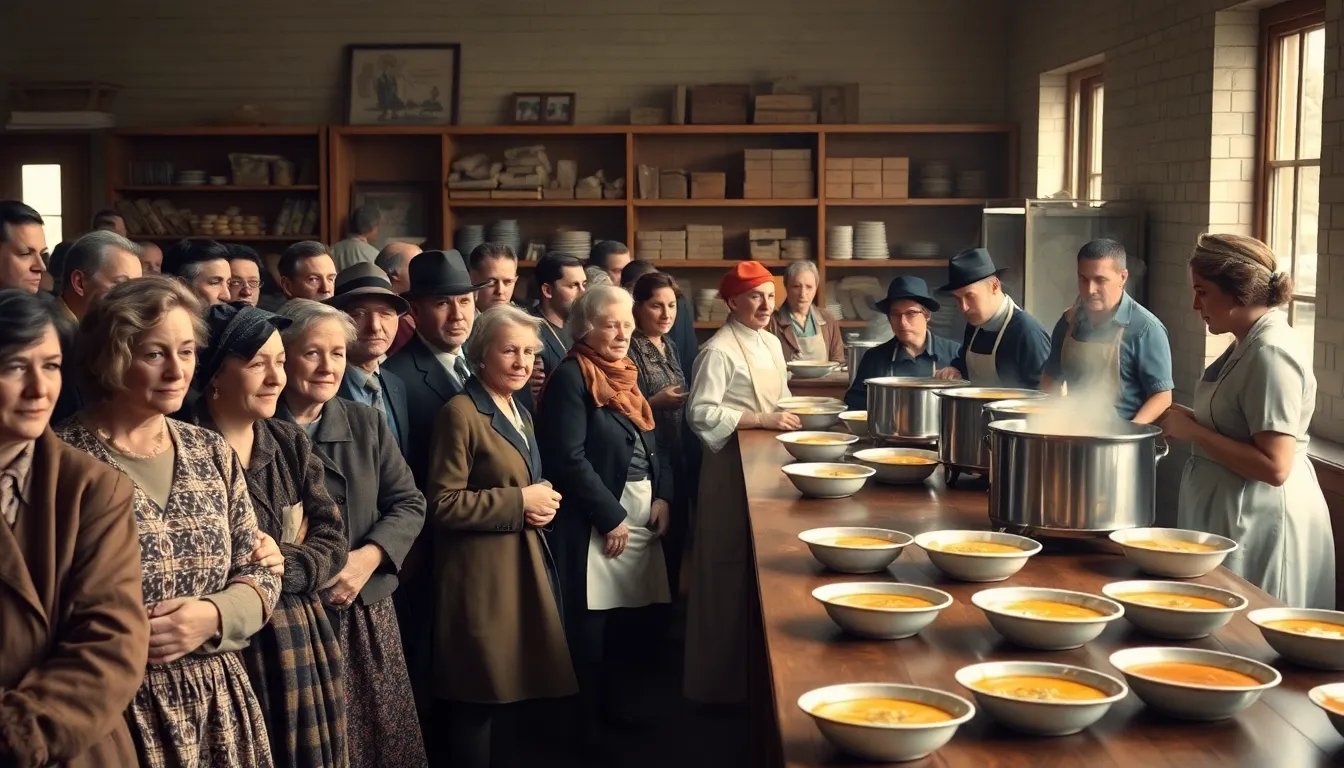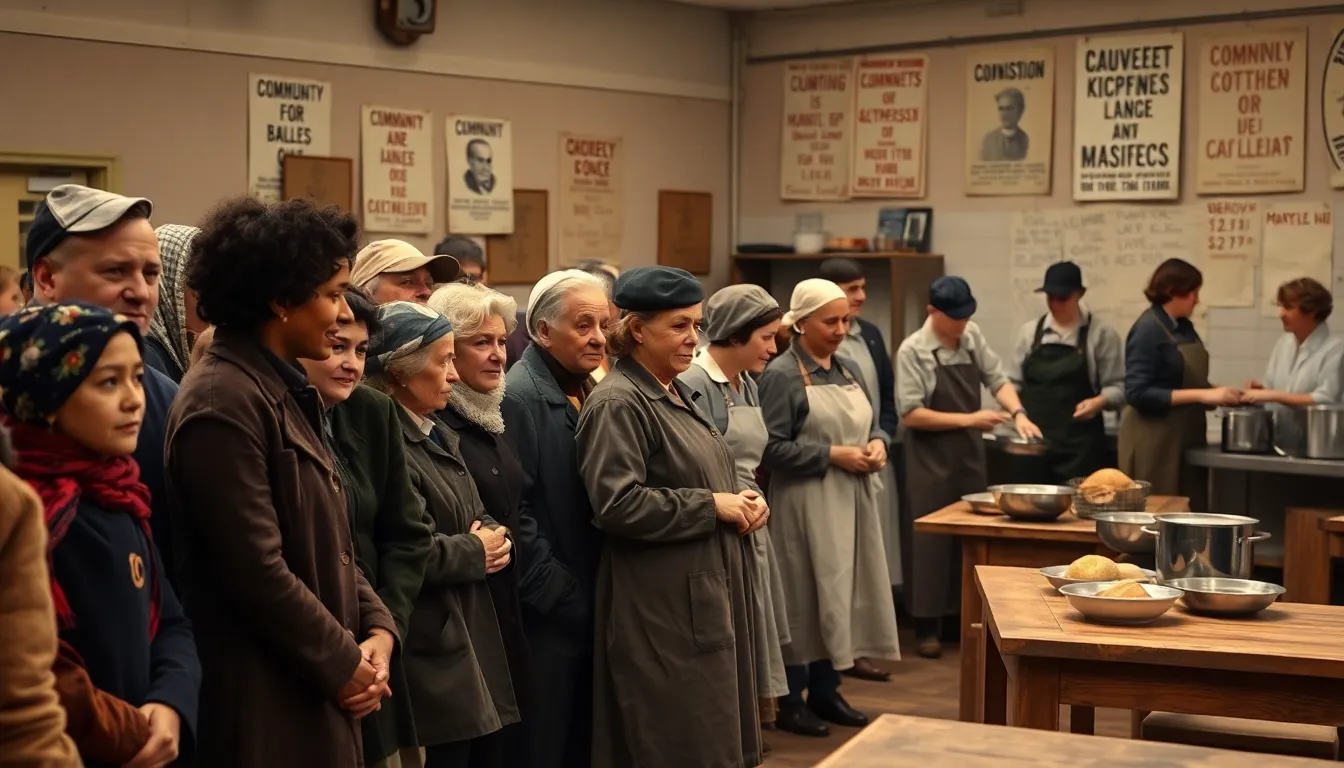Table of Contents
ToggleImagine standing in a long line, your stomach grumbling louder than a train whistle, anxiously awaiting a hot bowl of soup. Not your pleasant Sunday brunch with friends, but soup that could be the difference between skipping a meal or filling an empty belly. During the Great Depression, soup kitchens became a beacon of hope for many, serving not just food but dignity. Embracing the irony of economic turmoil, these humble establishments lined the streets of America, offering solace in a bowl. Let’s jump into the simmering history of soup kitchens during this challenging era and discover their profound impact on society.
Historical Context of The Great Depression

The Great Depression, starting with the stock market crash of 1929, marked an era of unprecedented financial despair. Often described as the worst economic downturn in modern history, it enveloped the world in a shroud of uncertainty. Businesses crumbled, banks closed their doors, and unemployment soared to staggering heights, leaving millions in dire straits. As families faced job losses and diminished savings, their ability to support themselves eroded rapidly. The hunger that ensued wasn’t just a personal issue: it transformed into a national crisis. This backdrop accentuated the need for soup kitchens, which sprang up across cities, transforming community kitchens into lifelines for those in need.
Economic Impact Leading to Food Insecurity
The economic fallout from the Great Depression was catastrophic and far-reaching. With joblessness peaking at an estimated 25%, many families struggled to put food on the table. Wages plummeted, and the price of basic necessities skyrocketed, leading to a paradox where food was available yet unaffordable. Farmers, once thriving, saw their crops rot as they couldn’t afford to harvest them. This widespread poverty led individuals to seek help outside their family units. Soup kitchens emerged as a crucial stopgap in addressing the immediate hunger crisis. Initially organized by religious groups and community volunteers, these kitchens recognized that no one should endure the gnawing ache of emptiness in their bellies.
Establishment and Operations of Soup Kitchens
The establishment of soup kitchens was often spontaneous, rooted in the need to address urgent hunger. In urban areas, local churches and charities spearheaded the movement, transforming basements and halls into makeshift kitchens. Meanwhile, in more rural areas, community members often banded together with whatever resources they could muster. These kitchens provided more than just a meal: they served as safe havens where individuals found a sense of community amidst despair. Typically, soup kitchens offered a simple, rotating menu, often just a hearty soup, bread, and maybe dessert. Volunteers of all ages arrived to chop vegetables, stir pots, and serve food with compassion. It wasn’t glamorous, but it was necessary, and for many, each bowl served contained not just nourishment but a sprinkle of hope.
Role of Charitable Organizations and Government Programs
As the Great Depression stretched on, the burden on soup kitchens surged, prompting a response from both charitable organizations and the government. Groups like the Salvation Army and local churches were instrumental in organizing food distributions, setting the stage for broader, more structured initiatives. In 1933, President Franklin D. Roosevelt launched the Federal Emergency Relief Administration (FERA), which aimed to provide immediate aid to those in need. This program facilitated the rapid creation of more soup kitchens and food distribution points. The collaboration between public and private sectors underscored the growing recognition that addressing food insecurity required a united front. Resources flowed as government funding supported small-scale kitchens, expanding their reach and capabilities.
Daily Life in a Soup Kitchen
For many patrons, daily life in a soup kitchen was a mix of routine and camaraderie. As individuals gathered, conversations flourished and friendships blossomed. For some, it was a regular part of their day: for others, a last resort. The environment within these kitchens often balanced the gravity of hunger with moments of levity and togetherness. Children played nearby while adults discussed their struggles and shared stories, even cracking jokes to lighten the heavy atmosphere. Soup kitchens became vibrant hubs that fostered a sense of belonging in an otherwise isolating situation. Everyone shared the understanding that they were weathering the same storm, creating bonds that would last beyond the soup and bread.
Cultural Significance and Lasting Impact
The cultural significance of soup kitchens during the Great Depression transcended their role as mere food providers. They became symbols of community resilience and human compassion. Stories of individuals coming together to support one another filled newspaper columns. Art, literature, and music of the time reflected the struggles faced, weaving together narratives that honored those who served and those who received. The existence of soup kitchens helped shift societal views on poverty, urging people to understand that hunger could befall anyone. As such, these establishments left an indelible mark on American culture, reminding people of kindness’s power in unimaginable circumstances.
Lessons Learned from The Great Depression
The soup kitchens of the Great Depression imparted crucial lessons about resilience, empathy, and community. They illustrated the importance of collective action in times of crisis, showcasing how grassroots movements can address urgent needs. The empathy displayed by volunteers both inspired future generations and contributed to the establishment of social safety nets. These kitchens highlighted the necessity for communities to support their vulnerable members, fostering a culture of shared responsibility. In today’s context, we can still draw on these lessons, particularly as global challenges emerge. Food insecurity continues to affect millions, underscoring the need for continued vigilance and action to prevent hunger in our society.





